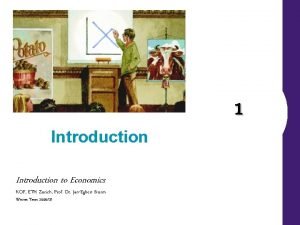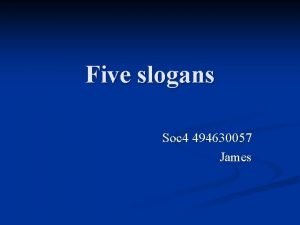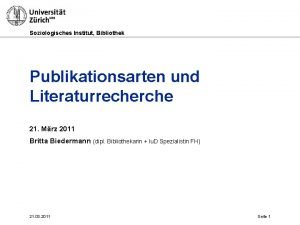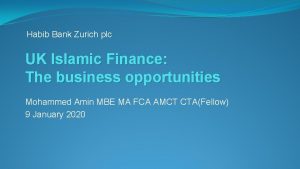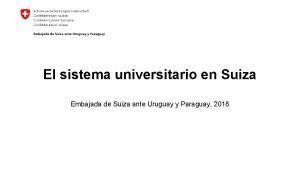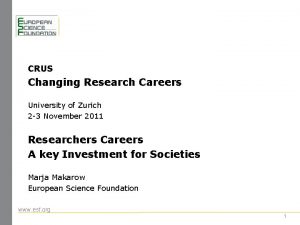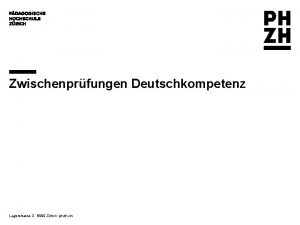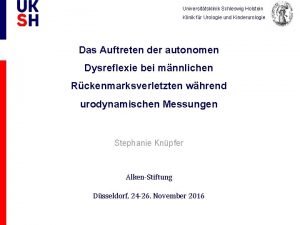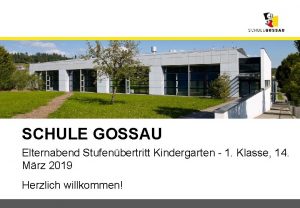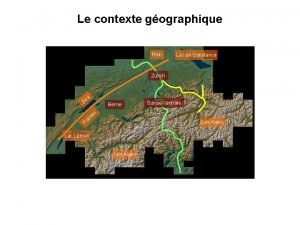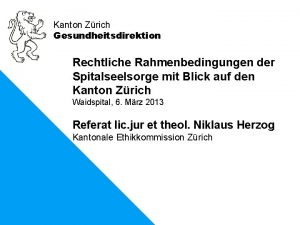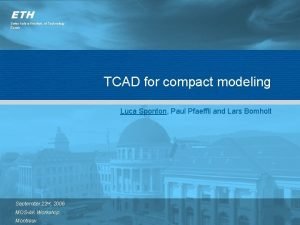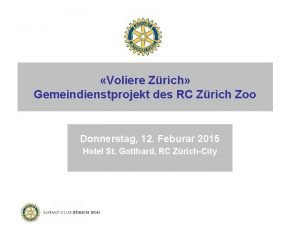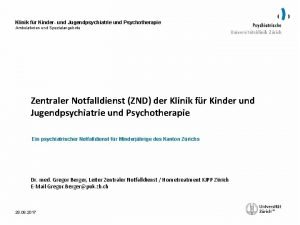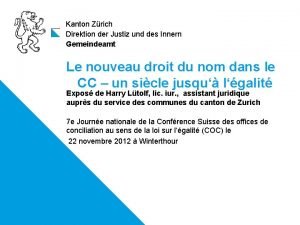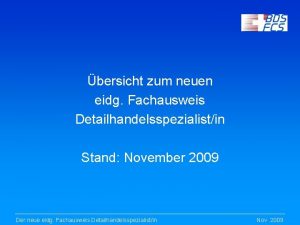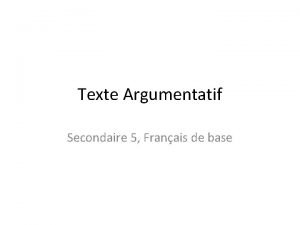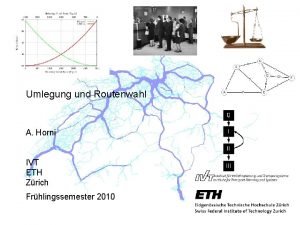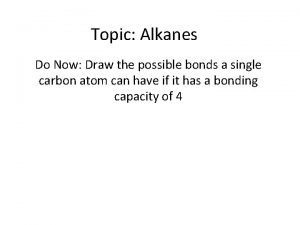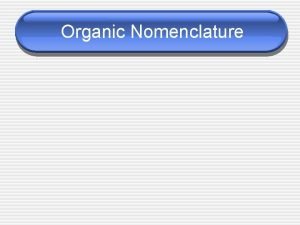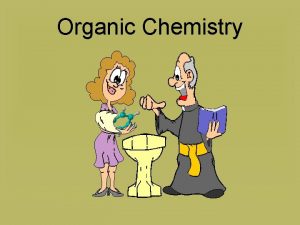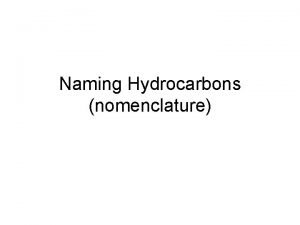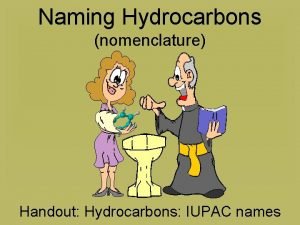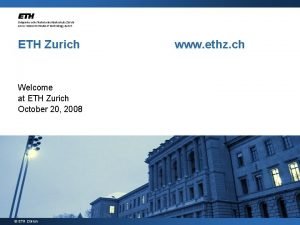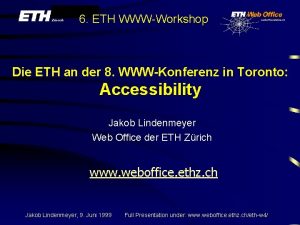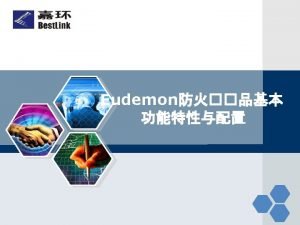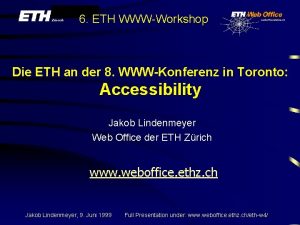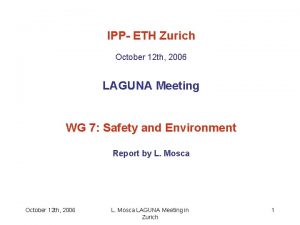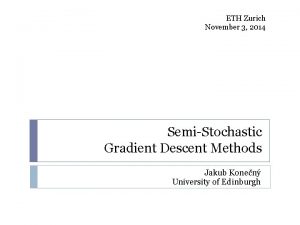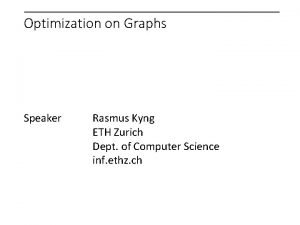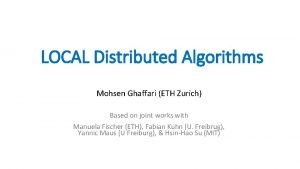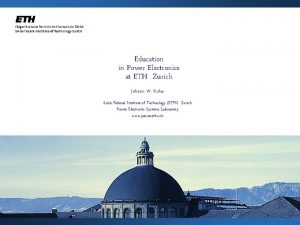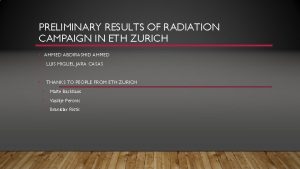Introduction to Economics KOF ETH Zurich Prof Dr




































- Slides: 36

Introduction to Economics KOF, ETH Zurich, Prof. Dr. Jan-Egbert Sturm Winter Term 2006/07 1

General Information • Prof. Dr. Jan-Egbert Sturm • office hours: Tue, 14 -15 h. • sturm@kof. ethz. ch • Frank Somogyi • somogyi@kof. ethz. ch Konjunkturforschungsstelle Swiss Institute for Business Cycle Research KOF

General Information • Internet: http: //www. vwl. ethz. ch • Literature: • Mankiw/Taylor (2006): Economics, Thomson Learning. • Translations: • Grundzüge der Volkswirtschaftslehre (2004), Schäffer-Poeschel • Principes de l'économie (1998), Economica • Principi di economia (2004), Zanichelli • Brunetti: Volkswirtschaftslehre – Eine Einführung für die Schweiz Konjunkturforschungsstelle Swiss Institute for Business Cycle Research KOF

Tuesday, October 31


General Information 24. 10. Introduction; Transformation Curve, Opportunity Cost Mankiw ch. 1, 2 31. 10. Markets: Demand Supply Ch. 4 7. 11. Elasticities Ch. 5 14. 11. Costs, Production Function Ch. 13 21. 11. Markets with perfect competiton Ch. 7, 14 28. 11. Taxation Ch. 8 5. 12. International Trade Ch. 9 12. Imperfect competition: Monopoly, and Oligoploy Ch. 15, 16 19. 12. Public Goods, Externalities Ch. 10, 11 9. 1. National Accounting, Gross Domestic Product, Growth Ch. 23, 25 16. 1. Money and Inflation Ch. 24, 29, 30 23. 1. Business Cycles Ch. 33, 34 30. 1. Open Economy Macro Ch. 31 Konjunkturforschungsstelle Swiss Institute for Business Cycle Research KOF

Thinking Like an Economist • Every field of study has its own terminology • Mathematics • integrals axioms vector spaces • Psychology • ego id cognitive dissonance • Law • promissory estoppel torts venues • Economics • supply opportunity cost elasticity consumer surplus demand comparative advantage deadweight loss Konjunkturforschungsstelle Swiss Institute for Business Cycle Research KOF

Thinking Like an Economist • Economics trains you to. . • Think in terms of alternatives. • Evaluate the cost of individual and social choices. • Examine and understand how certain events and issues are related. Konjunkturforschungsstelle Swiss Institute for Business Cycle Research KOF

Fundamental Economic Problem Resources are scarce Definition of Economics: • The study of how society manages its scarce resources Konjunkturforschungsstelle Swiss Institute for Business Cycle Research KOF

TEN PRINCIPLES OF ECONOMICS • How people make decisions. 1. 2. 3. 4. Konjunkturforschungsstelle Swiss Institute for Business Cycle Research People face trade-offs. The cost of something is what you give up to get it. Rational people think at the margin. People respond to incentives. KOF

TEN PRINCIPLES OF ECONOMICS • How people interact with each other. 5. Trade can make everyone better off. 6. Markets are usually a good way to organize economic activity. 7. Governments can sometimes improve economic outcomes. Konjunkturforschungsstelle Swiss Institute for Business Cycle Research KOF

TEN PRINCIPLES OF ECONOMICS • The forces and trends that affect how the economy as a whole works. 8. The standard of living depends on a country’s production. 9. Prices rise when the government prints too much money. 10. Society faces a short-run trade-off between inflation and unemployment. Konjunkturforschungsstelle Swiss Institute for Business Cycle Research KOF

The Scientific Method: Observation, Theory, and More Observation • Uses abstract models to help explain how a complex, real world operates. • Develops theories, collects, and analyzes data to evaluate theories. Konjunkturforschungsstelle Swiss Institute for Business Cycle Research KOF

The Scientific Method: Observation, Theory, and More Observation • What is a model? • • a model is a simplified representation of reality example: topographic map a 1: 1 map is useless simplification is necessary • Economics uses mathematics, but it is NOT an exact science. Konjunkturforschungsstelle Swiss Institute for Business Cycle Research KOF

The Role of Assumptions • Economists make assumptions in order to make the world easier to understand. • The art in scientific thinking is deciding which assumptions to make. • Economists use different assumptions to answer different questions. Konjunkturforschungsstelle Swiss Institute for Business Cycle Research KOF

Economic Models • Economists use models to simplify reality in order to improve our understanding of the world • Two of the most basic economic models include: • The Circular Flow Diagram • The Production Possibilities Frontier Konjunkturforschungsstelle Swiss Institute for Business Cycle Research KOF

Our First Model: The Circular-Flow Diagram • The circular-flow diagram is a visual model of the economy that shows how dollars flow through markets among households and firms. Konjunkturforschungsstelle Swiss Institute for Business Cycle Research KOF

Our First Model: The Circular-Flow Diagram • Firms • Produce and sell goods and services • Hire and use factors of production • Households • Buy and consume goods and services • Own and sell factors of production Konjunkturforschungsstelle Swiss Institute for Business Cycle Research KOF

Our First Model: The Circular-Flow Diagram • Markets for Goods and Services • Firms sell • Households buy • Markets for Factors of Production • Households sell • Firms buy Konjunkturforschungsstelle Swiss Institute for Business Cycle Research KOF

Our First Model: The Circular-Flow Diagram • Factors of Production • Inputs used to produce goods and services • Land, labor, and capital Konjunkturforschungsstelle Swiss Institute for Business Cycle Research KOF

Figure 1 The Circular Flow MARKETS FOR GOODS AND SERVICES • Firms sell Goods • Households buy and services sold Revenue Wages, rent, and profit Goods and services bought HOUSEHOLDS • Buy and consume goods and services • Own and sell factors of production FIRMS • Produce and sell goods and services • Hire and use factors of production Factors of production Spending MARKETS FOR FACTORS OF PRODUCTION • Households sell • Firms buy Labor, land, and capital Income = Flow of inputs and outputs = Flow of dollars Copyright © 2004 South-Western

Our Second Model: The Production Possibilities Frontier • The production possibilities frontier is a graph that shows the combinations of output that the economy can possibly produce given the available factors of production and the available production technology. Konjunkturforschungsstelle Swiss Institute for Business Cycle Research KOF

Figure 2 The Production Possibilities Frontier Quantity of Computers Produced 3, 000 D C 2, 200 2, 000 A Production possibilities frontier B 1, 000 0 300 600 700 1, 000 Quantity of Cars Produced Copyright© 2003 Southwestern/Thomson Learning

Our Second Model: The Production Possibilities Frontier • Concepts Illustrated by the Production Possibilities Frontier • • Konjunkturforschungsstelle Swiss Institute for Business Cycle Research Efficiency Tradeoffs Opportunity Cost Economic Growth KOF

Figure 3 A Shift in the Production Possibilities Frontier Quantity of Computers Produced 4, 000 3, 000 2, 100 2, 000 0 E A 700 750 1, 000 Quantity of Cars Produced Copyright © 2004 South-Western

Microeconomics and Macroeconomics • Microeconomics focuses on the individual parts of the economy. • How households and firms make decisions and how they interact in specific markets • Macroeconomics looks at the economy as a whole. • Economy-wide phenomena, including inflation, unemployment, and economic growth Konjunkturforschungsstelle Swiss Institute for Business Cycle Research KOF

THE ECONOMIST AS POLICY ADVISOR • When economists are trying to explain the world, they are scientists. • When economists are trying to change the world, they are policy advisor. Konjunkturforschungsstelle Swiss Institute for Business Cycle Research KOF

POSITIVE VERSUS NORMATIVE ANALYSIS • Positive statements are statements that attempt to describe the world as it is. • Called descriptive analysis • Normative statements are statements about how the world should be. • Called prescriptive analysis Konjunkturforschungsstelle Swiss Institute for Business Cycle Research KOF

POSITIVE VERSUS NORMATIVE ANALYSIS • Positive or Normative Statements? • An increase in the minimum wage will cause a decrease in employment among the least-skilled. POSITIVE • Higher federal budget deficits will cause interest rates to increase. POSITIVE Konjunkturforschungsstelle Swiss Institute for Business Cycle Research KOF

POSITIVE VERSUS NORMATIVE ANALYSIS • Positive or Normative Statements? • The income gains from a higher minimum wage are worth more than any slight reductions in employment. NORMATIVE • State governments should be allowed to collect from tobacco companies the costs of treating smoking-related illnesses among the poor. NORMATIVE Konjunkturforschungsstelle Swiss Institute for Business Cycle Research KOF

WHY ECONOMISTS DISAGREE • They may disagree about the validity of alternative positive theories about how the world works. • They may have different values and, therefore, different normative views about what policy should try to accomplish. Konjunkturforschungsstelle Swiss Institute for Business Cycle Research KOF

DO ECONOMISTS AGREE? • A ceiling on rents reduces the quantity and quality of housing available • 93% • Tariffs and import quotas usually reduce general economic welfare • 93% • Fiscal policy has a significant stimulative impact on a less than fully employed economy • 90% • If the government budget is to be balanced, it should be done over the business cycle rather than yearly • 85% • A minimum wage increases unemployment among young and unskilled workers • 79% Konjunkturforschungsstelle Swiss Institute for Business Cycle Research KOF

Summary • Economists try to address their subjects with a scientist’s objectivity. • They make appropriate assumptions and build simplified models in order to understand the world around them. • Two simple economic models are the circular-flow diagram and the production possibilities frontier. Konjunkturforschungsstelle Swiss Institute for Business Cycle Research KOF

Summary • Economics is divided into two subfields: • Microeconomists study decisionmaking by households and firms in the marketplace. • Macroeconomists study the forces and trends that affect the economy as a whole Konjunkturforschungsstelle Swiss Institute for Business Cycle Research KOF

Summary • A positive statement is an assertion about how the world is. • A normative statement is an assertion about how the world ought to be. • When economists make normative statements, they are acting more as policy advisors than scientists. Konjunkturforschungsstelle Swiss Institute for Business Cycle Research KOF

Summary • Economists who advise policymakers offer conflicting advice either because of differences in scientific judgments or because of differences in values. • At other times, economists are united in the advice they offer, but policymakers may choose to ignore it. Konjunkturforschungsstelle Swiss Institute for Business Cycle Research KOF
 Kof eth
Kof eth Kof-n
Kof-n Maastricht university economics and business economics
Maastricht university economics and business economics What is mathematical economics
What is mathematical economics Installationsattest kanton zürich
Installationsattest kanton zürich Soziologisches institut zürich bibliothek
Soziologisches institut zürich bibliothek Zurich bank uk
Zurich bank uk Universidad de zúrich egresados notables
Universidad de zúrich egresados notables Www.bfs-winterthur.ch
Www.bfs-winterthur.ch Volkschulamt
Volkschulamt Wta formular zürich
Wta formular zürich Zurich notebook
Zurich notebook University of zurich careers
University of zurich careers Zurich intermediaries protection
Zurich intermediaries protection Phzh ilias
Phzh ilias Kinderurologie zürich
Kinderurologie zürich Zeugnisreglement kanton zürich
Zeugnisreglement kanton zürich Zurich constance
Zurich constance Bestattungsverordnung kanton zürich
Bestattungsverordnung kanton zürich Zurich
Zurich Ebi zürich
Ebi zürich Zurich subguard
Zurich subguard Zoo zürich
Zoo zürich Ulrich zwingli
Ulrich zwingli Zurich public sector
Zurich public sector Puk winterthur
Puk winterthur Direktion der justiz und des innern kanton zürich
Direktion der justiz und des innern kanton zürich Detailhandelsspezialist zürich
Detailhandelsspezialist zürich Introduction texte argumentatif exemple
Introduction texte argumentatif exemple Umlegung
Umlegung Eth meth prop but
Eth meth prop but Ane ene yne formula
Ane ene yne formula Meth eth prop but
Meth eth prop but Organic chem crash course
Organic chem crash course Hydrocarbons contain only _____.
Hydrocarbons contain only _____. Ethyl methyl propyl
Ethyl methyl propyl Meth eth prop but
Meth eth prop but
